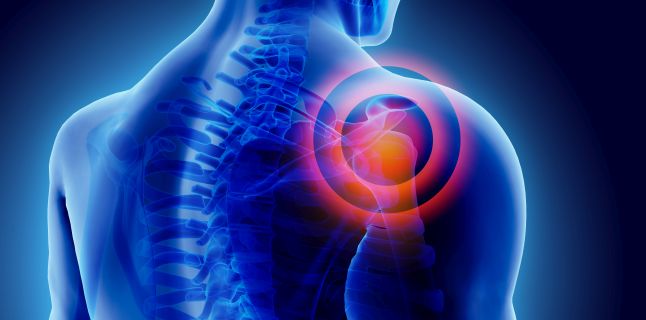Shoulder's disease blocked or frozen

The active voluntary movements and those caused by the examiner, called passive movements, are very limited. The patient declares that he has a stiff shoulder, can not make any movement and accusations and a permanent pain, which is accentuated by the mobilization attempts. The patient can lift the arm horizontally with ease, but is unable to lift it more; . In addition to classical signs and symptoms, two types of adhesive capsule have been described, each with different stages of onset. Primary adherent capsule comprises: - Phase I or painful phase, characterized by diffuse pains that extend over weeks, months, and even years, with nocturnal phases and progressive limiting of movements. - phase II or blockage phase, which is highlighted by the marked limitation of the movements between 4-12 months and the persistence of constant pain, slightly accentuated by the attempt of self-denial of limits imposed by immobility.
- Phase III or resolution phase in which pain relief occurs and a decrease in blockage. Secondary adherent capsule, as the name calls it, occurs after an overuse or after a trauma, and in this case the phases are no longer respected. It is established after the patient's examination, sometimes quite late, after a few months or even years from the onset, and declares that he has a pain located at the shoulder but radiating in the upper limb. After the anamnesis and examination of the patient, one is indicated, which is often normal or may indicate small changes due to an older fracture. If the X-ray is not sufficient then a shoulder or artroRMN is recommended to see the decrease in the amount of articular fluid and possibly a shoulder ultrasound to predetermine the final diagnosis.
This condition can be corrected either conservatively or surgically in particularly rare cases. Generally, specific pain relieving medication, physical therapy for partial regression of mobility, and local infiltration with anti-inflammatory drugs (corticoids). This initial version may take several years, and if the effects are not the desired, surgical treatment is performed by orthopedic mini-incisions with sections of the thickened capsule to move the shoulder. Postoperative recovery is essential and requires kinetotherapy to maintain mobility and to prevent the shoulder from frozen again. Another important thing is the patient's learning of special moves from sessions to make them home alone; .
In the absence of treatment, the blockage persists for months, but ends up giving up little by little with time recovery if treatment is started. At every occurrence of pain or limitation of shoulder movements, we must present to our family doctor to identify the root cause and evaluate the condition. The doctor will examine the shoulder and will want to know the following: - When the first symptoms started, especially if they were after a road accident, after a fall, after an aggression, etc. . - how severe is pain in a step from 1 to 10 - whether or not it irradiates this pain to the upper limb - how this pain or discomfort affects your daily activities - if there are movements to improve or worsen .
The family doctor may apply small pressure to various parts of the shoulder to detect where the pain is more intense and evaluate the affection. It should also be followed by the occurrence of swelling (swelling), recent bruising, but also how weak the muscles are to differentiate a potential muscle stretch. The family doctor will decide what is best for the patient, continue the investigations, and initiate an appropriate treatment as soon as possible. .
Source : sfatulmedicului.ro
Views : 2522
Popular Article
- (photo) Nude becomes art.
Posted: 2018-03-17, 9112 views.
- The harmful effects of air conditioning on the skin
Posted: 2017-06-08, 7820 views.
- 3 causes of dyed hair discoloration
Posted: 2017-06-15, 7655 views.
- Why early puberty occurs in girls: symptoms, favors, diagnosis and treatment
Posted: 2017-10-24, 7531 views.
- Good or bad skin treatments in the hot season
Posted: 2017-06-07, 7286 views.
Recommendations
- (photo) Nude becomes art.
Posted: 2018-03-17, 9112 views.
- The harmful effects of air conditioning on the skin
Posted: 2017-06-08, 7820 views.
- 3 causes of dyed hair discoloration
Posted: 2017-06-15, 7655 views.
- Good or bad skin treatments in the hot season
Posted: 2017-06-07, 7286 views.
- Risks of practicing sports on hot days
Posted: 2017-06-12, 6880 views.
 4 effective ingredients in the fight against acne.
4 effective ingredients in the fight against acne. How to get rid of hiccups fast
How to get rid of hiccups fast The wheat bran diet: the secret of lost pounds as if by magic
The wheat bran diet: the secret of lost pounds as if by magic The recipe that will sweeten your soul this weekend!
The recipe that will sweeten your soul this weekend!  Is it dangerous or not to refreeze meat after thawing it?
Is it dangerous or not to refreeze meat after thawing it?  The unusual sign of diabetes indicated by saliva.
The unusual sign of diabetes indicated by saliva. What to drink to boost your immune system.
What to drink to boost your immune system. 10 foods that help you never age.
10 foods that help you never age. What actually happens in your body if you drink a cup of coffee for breakfast
What actually happens in your body if you drink a cup of coffee for breakfast 5 surprising benefits of chia seeds
5 surprising benefits of chia seeds